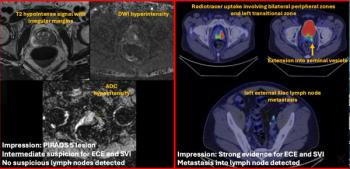Mammography Surveillance: Can Screening DBT Have an Impact After Breast Cancer Treatment?
In a study of over 30,000 screening digital breast tomosynthesis (DBT) exams for over 8,000 women, researchers found a specificity rate of 95.1 percent, a false negative rate of 2.1 (per 1,000 exams) and an abnormal interpretation rate (AIR) of 5.7 percent.
Emerging research suggests that digital breast tomosynthesis (DBT) can play a key role in the surveillance of patients who have been treated for breast cancer.
In the retrospective study, recently published in the
In addition to a sensitivity rate of 80.3 percent and a specificity rate of 95.1 percent, the researchers found that DBT had a false negative rate of 2.1 per 1,000 exams and an abnormal interpretation rate (AIR) of 5.7 percent over a 6.5-year period. The study authors pointed out that the highest AIR (7.5 percent) occurred less than or up to one year after initial diagnosis whereas the lowest AIR (5 percent) occurred between five to six years after breast cancer diagnosis.
“ … Although the AIR was higher during the initial years after diagnosis compared to subsequent years, the AIR remained below 10% in all years, including in the first year after diagnosis,” wrote study co-author Manisha Bahl, M.D., M.P.H., an associate professor of radiology at Harvard Medical School, and colleagues. “Given the acceptably low AIRs observed in the initial years after treatment, the present results support the study institution’s approach for mammographic surveillance in patients with a prior breast cancer diagnosis of returning immediately to screening with DBT.”
The researchers noted an overall cancer detection rate (CDR) for DBT of 8.6 per 1,000 exams. However, in contrast to previous literature reports indicating higher breast cancer recurrence rates within five years of treatment, the study authors noted the highest CDR in their study (11.2 per 1,000 exams) occurred between eight and nine years after the original diagnosis, and the lowest CDR (4.9 per 1,000 exams) occurred between two to three years after diagnosis.
“These results indicate that patients with a prior breast cancer diagnosis continue to be at elevated risk for breast cancer even after the first 5 years,” emphasized Bahl and colleagues.
Beyond the inherent limitations of a single-center retrospective study, the researchers acknowledged that the study cohort did not include symptomatic patients nor women referred for non-screening indications. Another factor limiting broader extrapolation of the study results was the lack of diversity in the cohort with researchers noting that 90.5 percent of the cohort were White women.
Newsletter
Stay at the forefront of radiology with the Diagnostic Imaging newsletter, delivering the latest news, clinical insights, and imaging advancements for today’s radiologists.





























